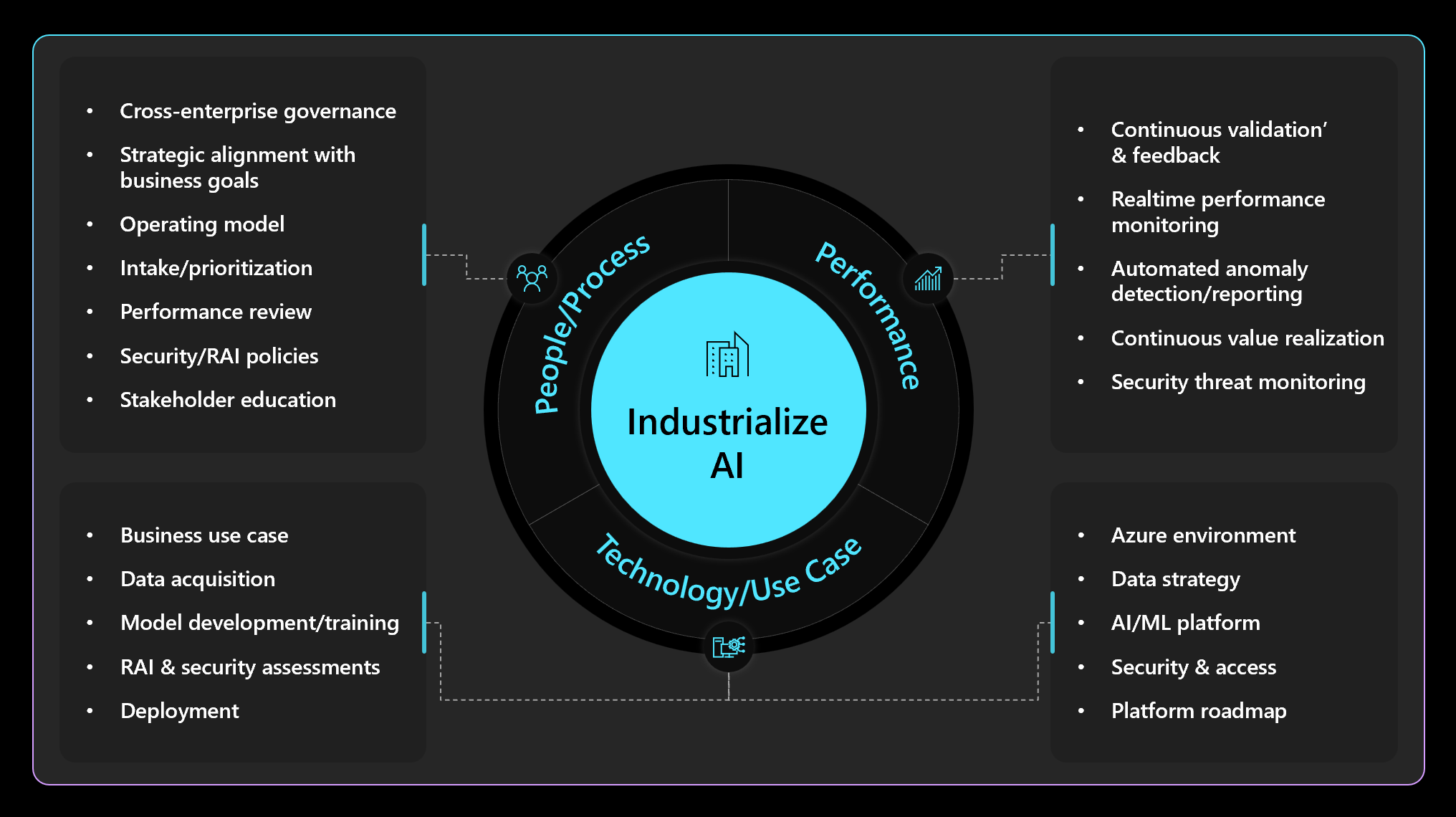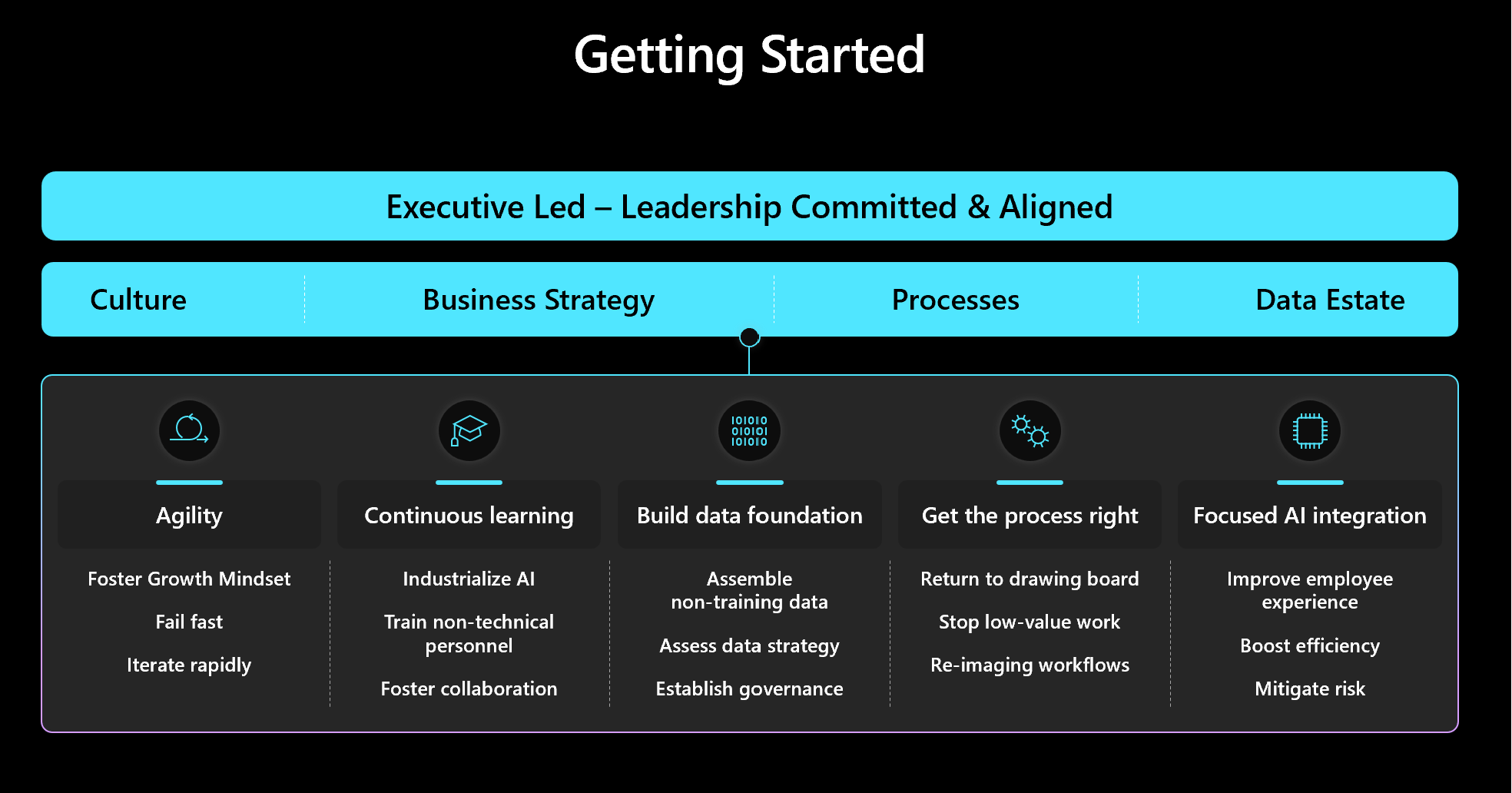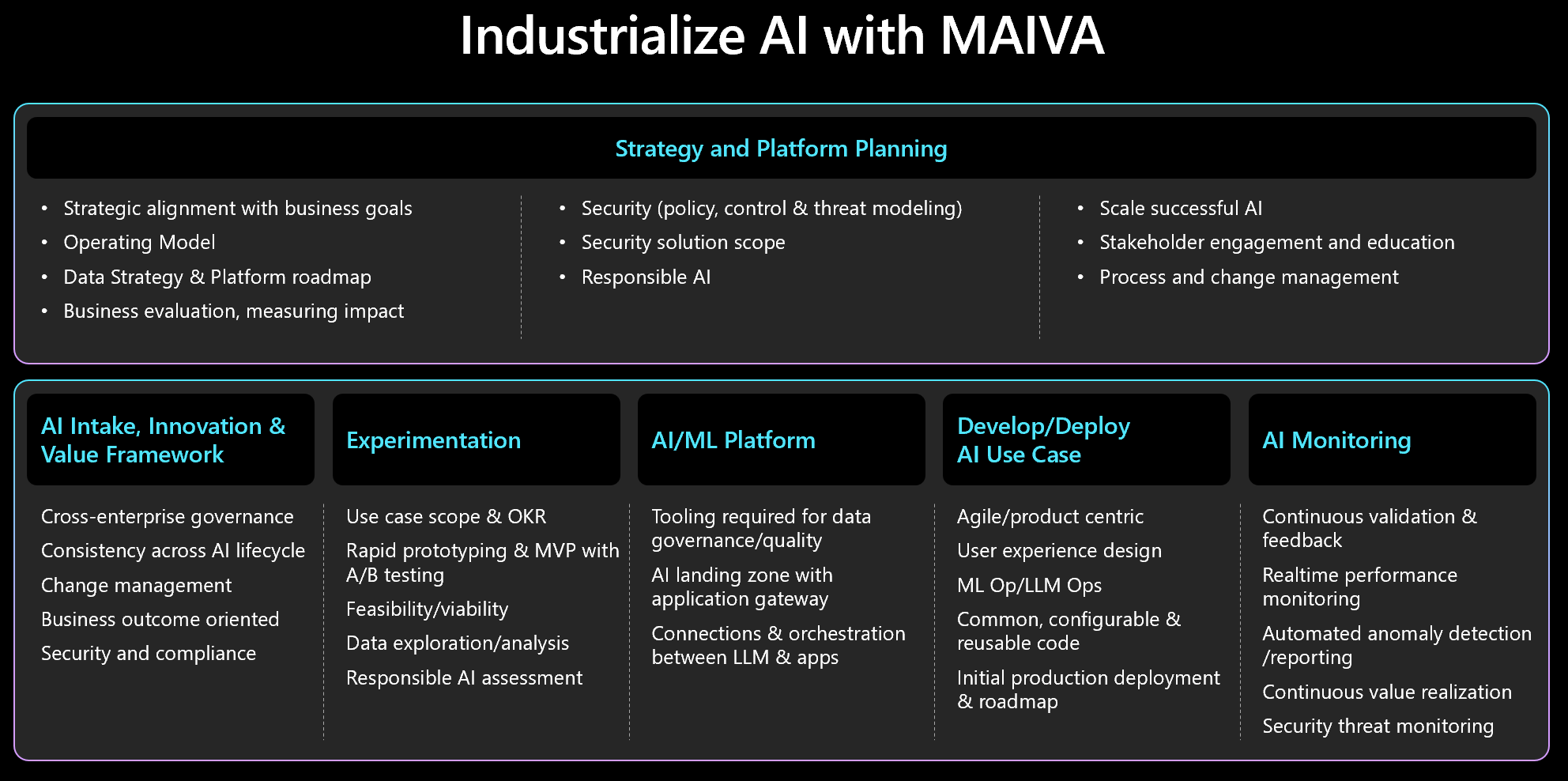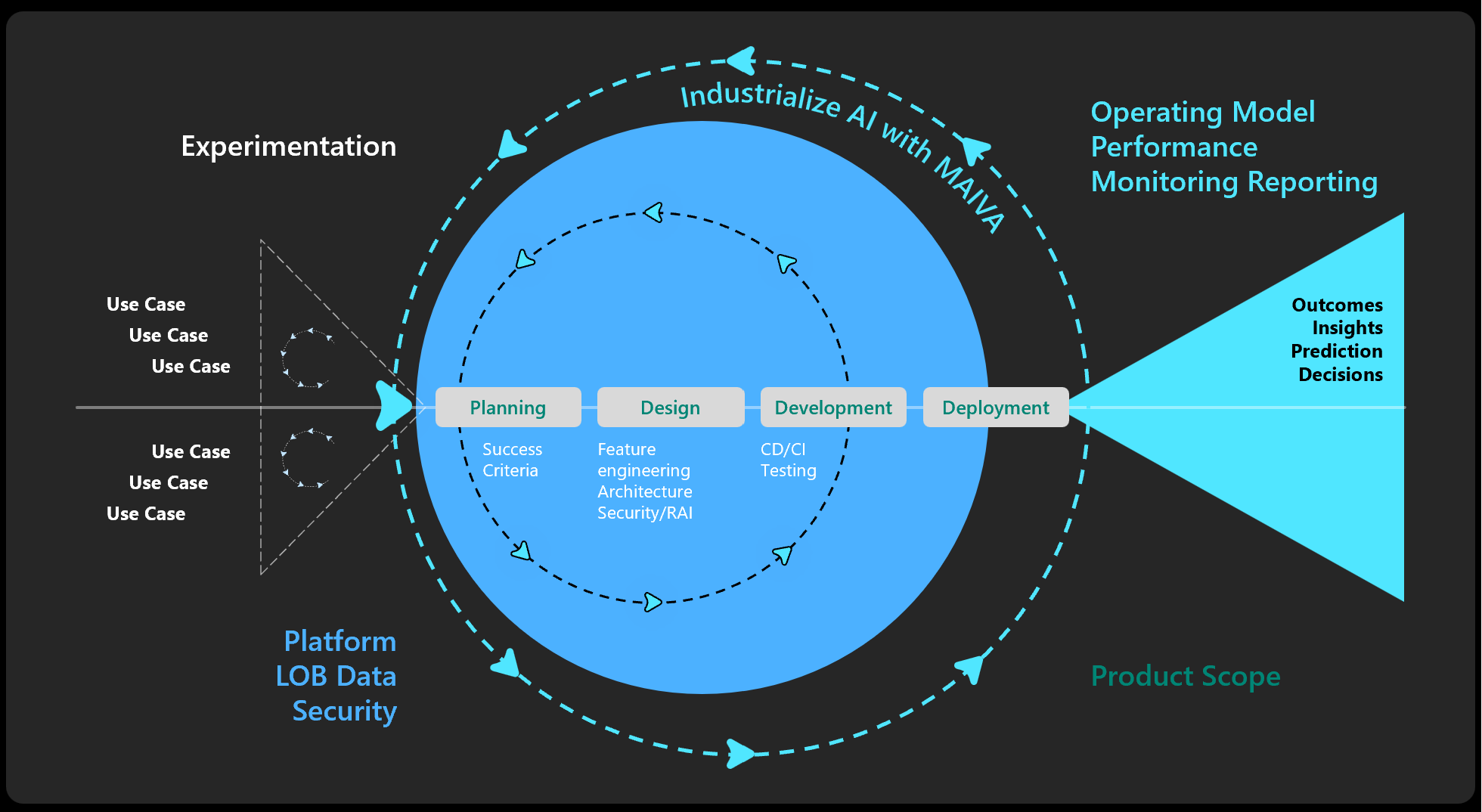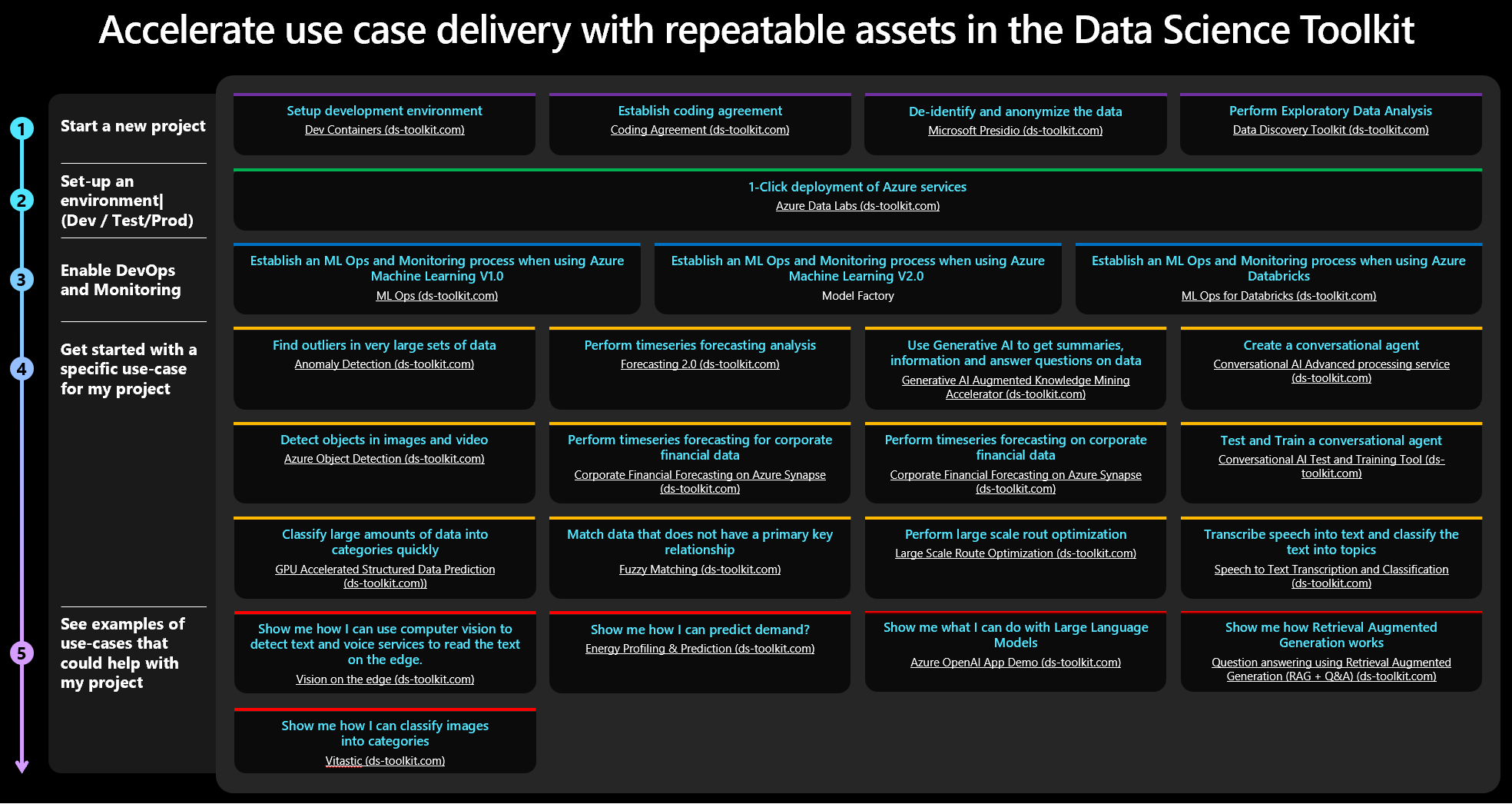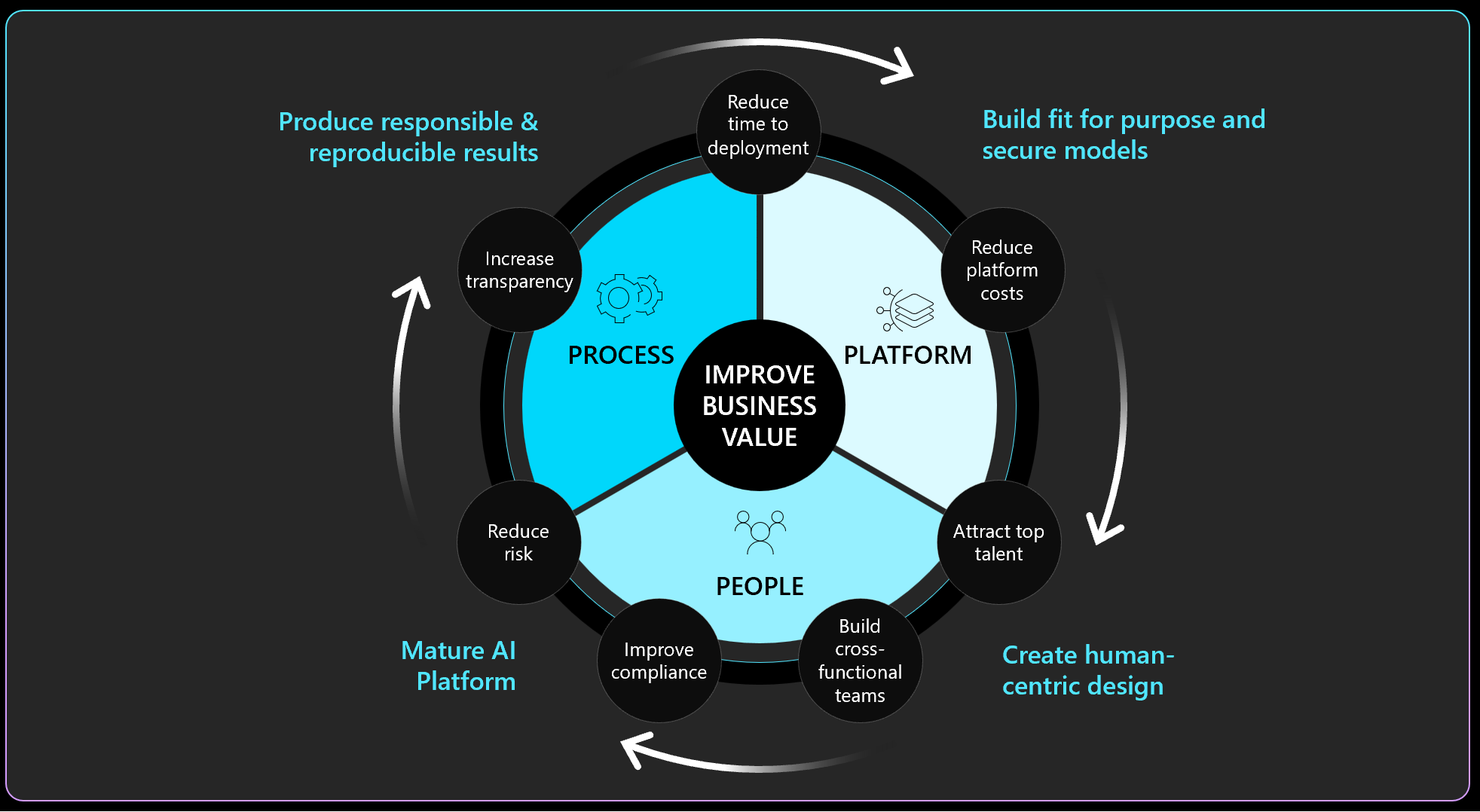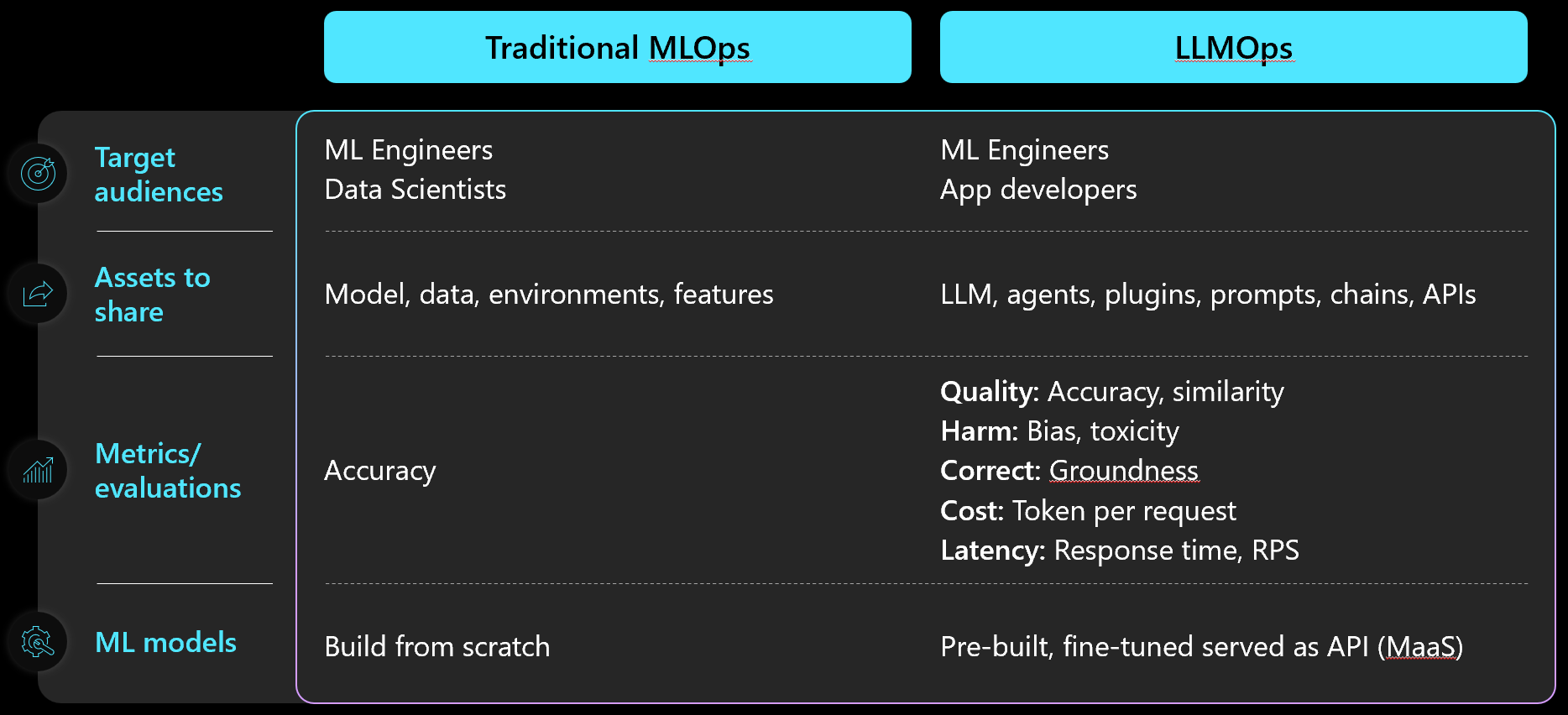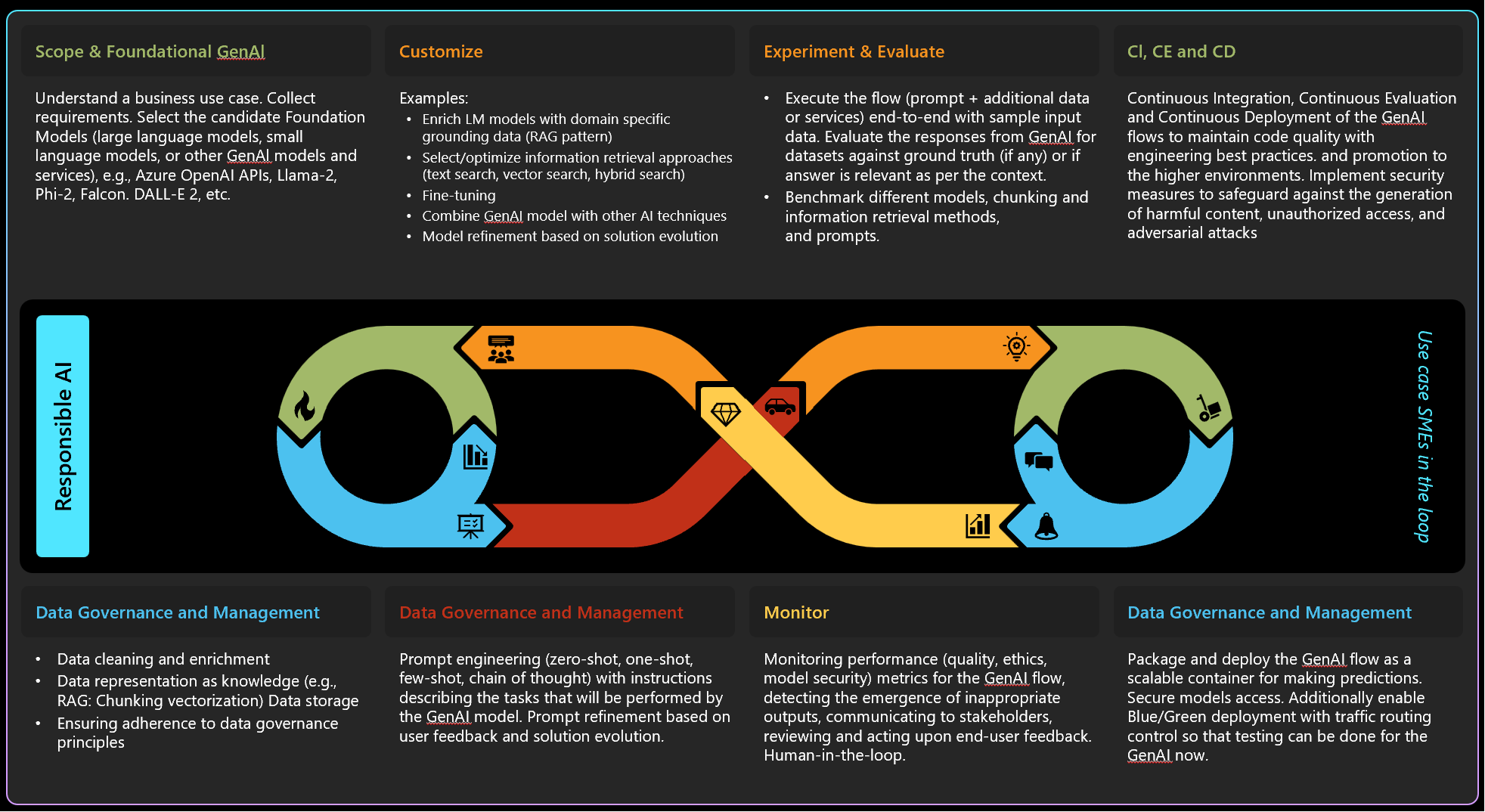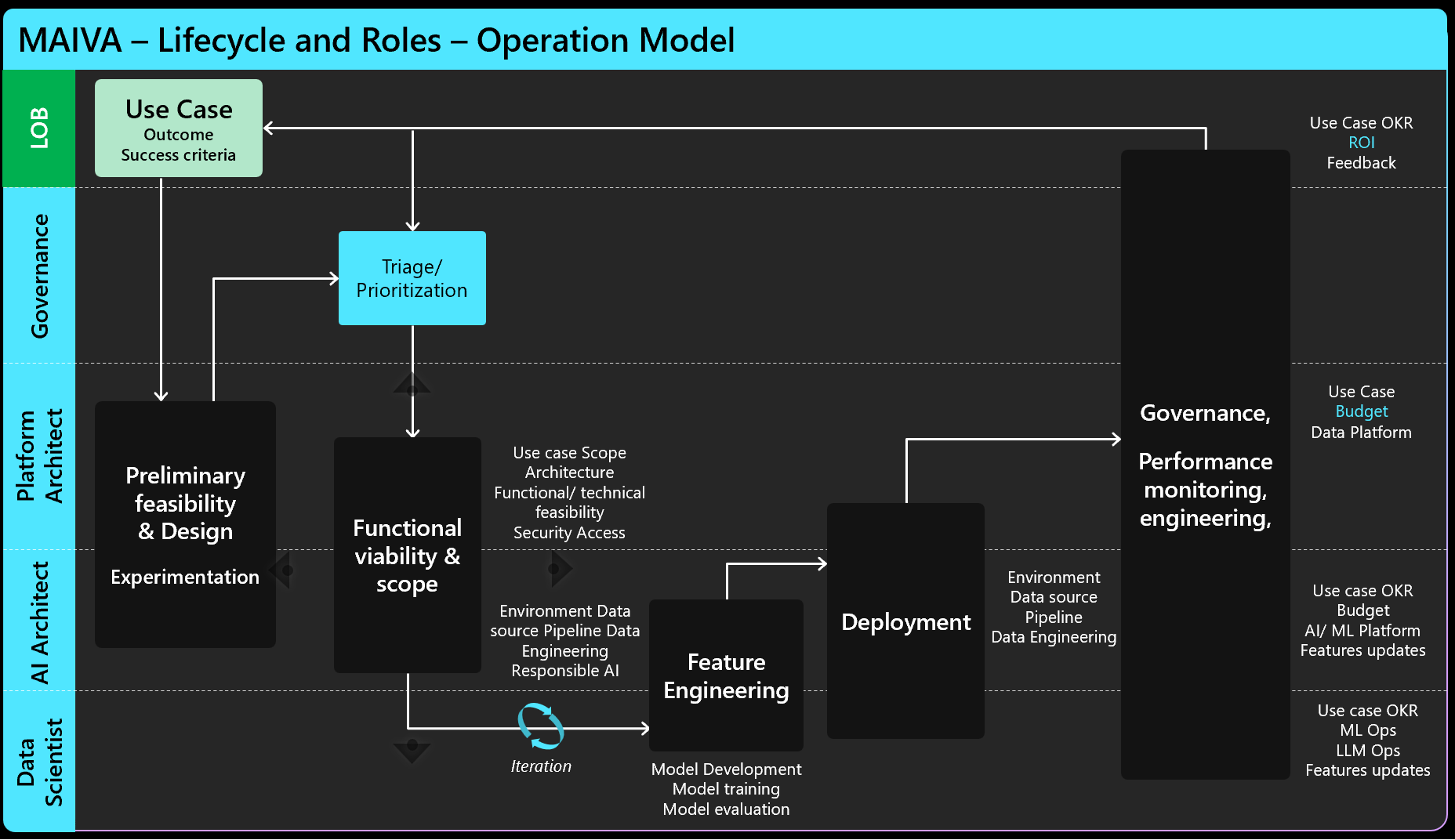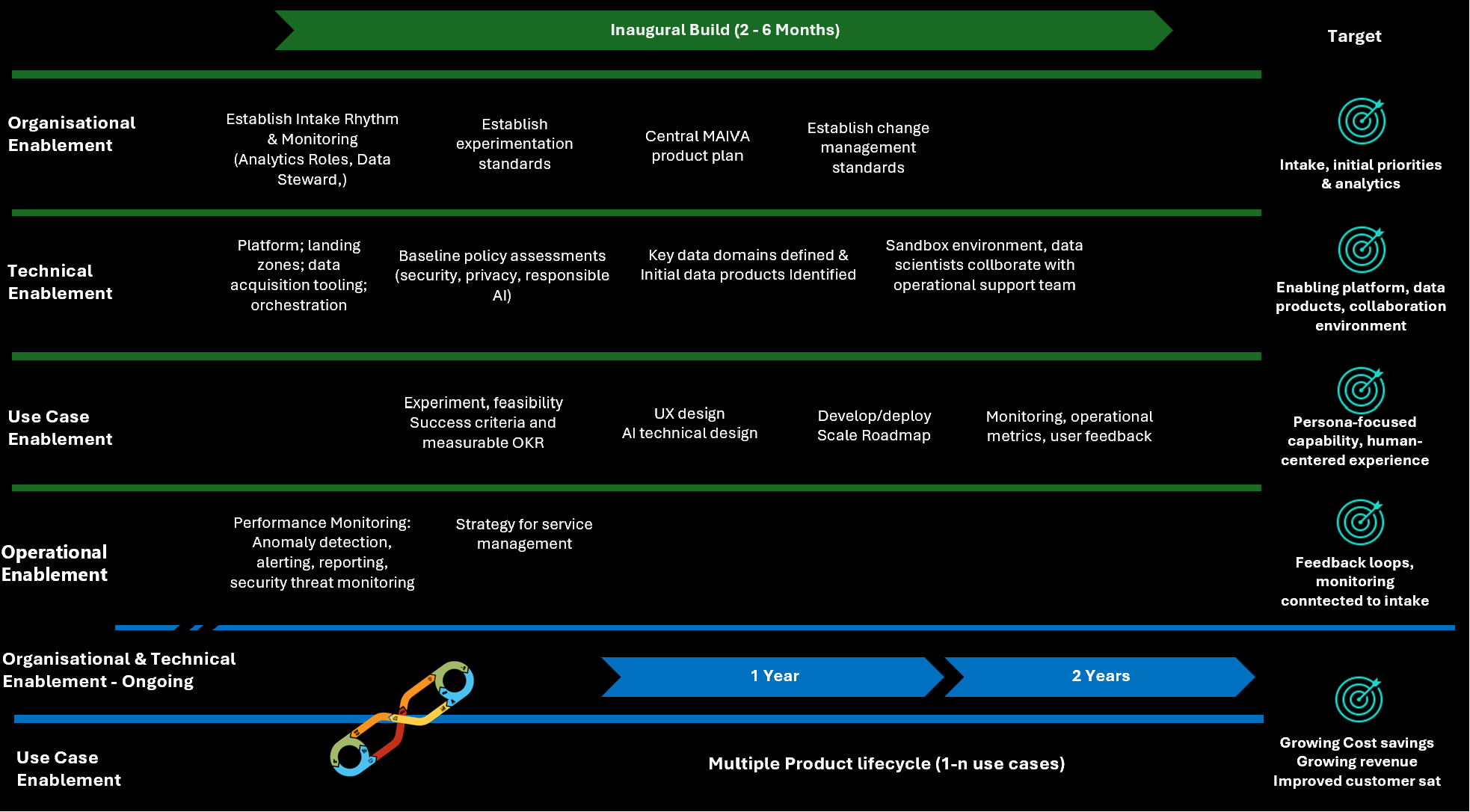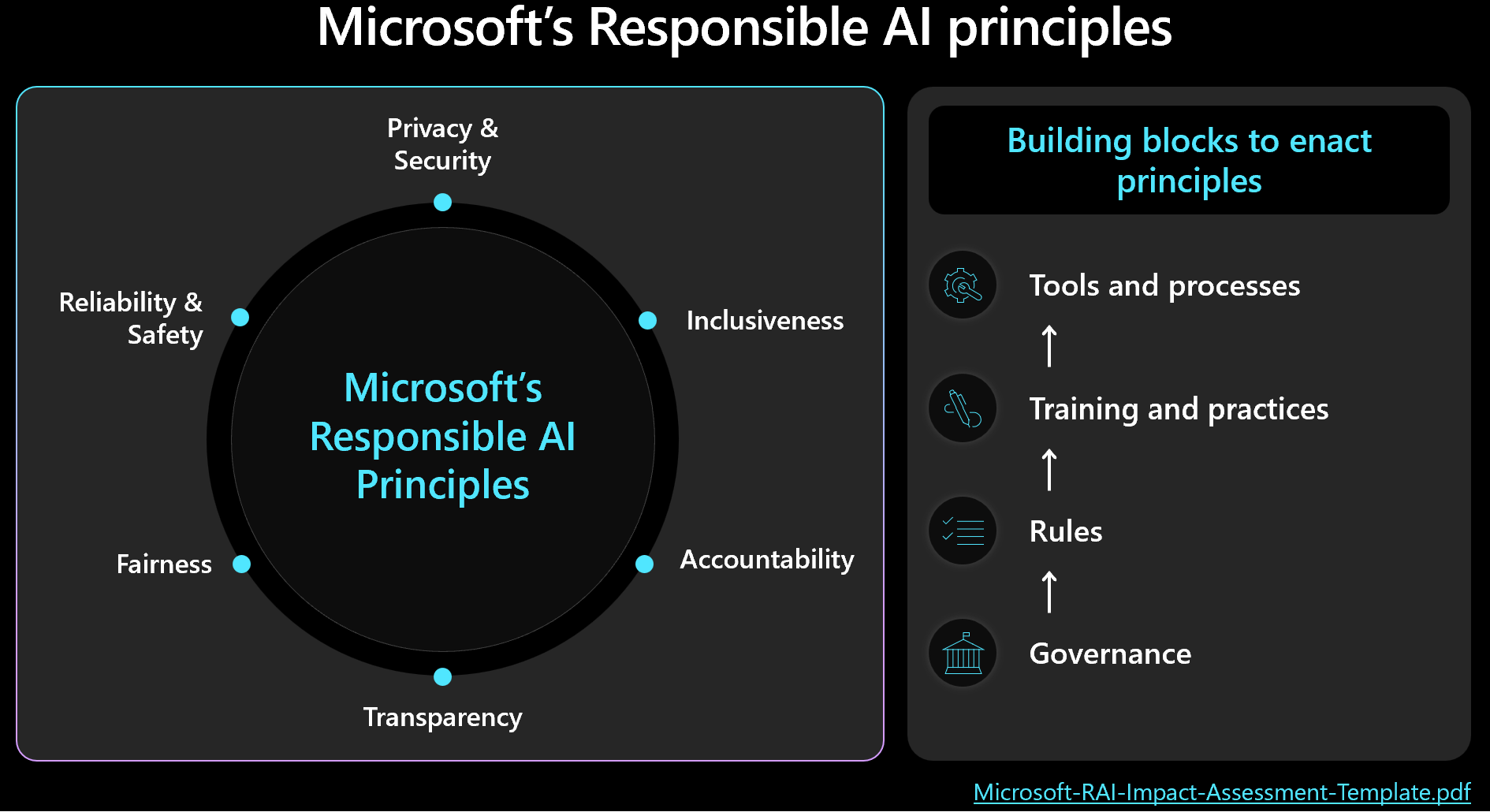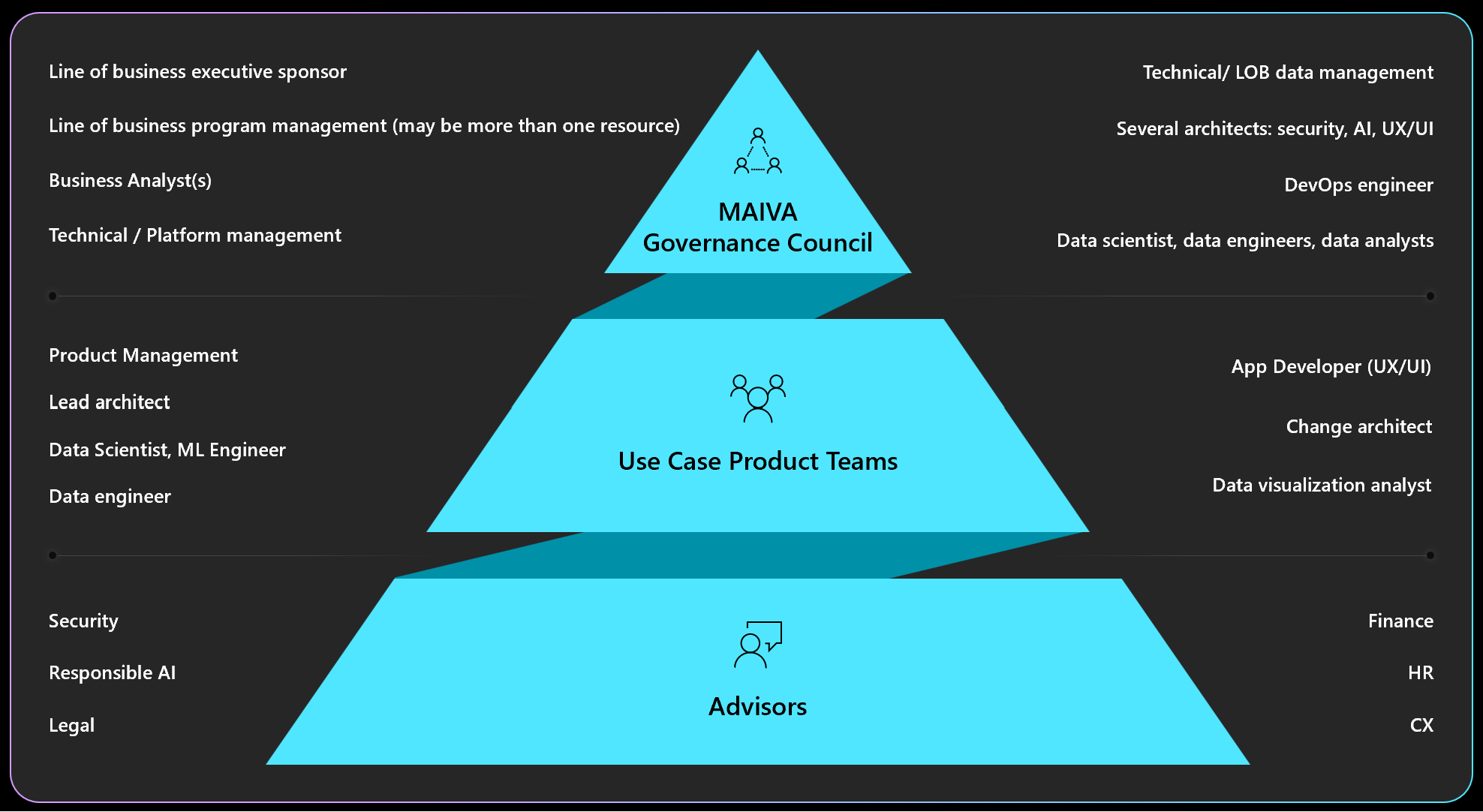dstoolkit-maiva
MAIVA - Framework Table of Contents
- Executive role in culture
- Systems thinking underpinning culture
- Being a data-driven culture
- Approach to change management
- MAIVA – AI strategy and platform planning
- MAIVA – Innovation, Intake, Experimentation
- MAIVA – the AI platform, the data platform, and the data (perpetual data strategy)
- MAIVA – Develop, Deploy & Operationalize AI/ML Use Case
MAIVA Operating model process and roadmap
Security & Responsible AI considerations in AI governance
Economics of governance framework (or the opportunity cost)
Introduction
How to use this playbook
As AI technologies rapidly evolve, companies increasingly struggle to realize the expected returns from investment in AI. It is not unusual to expect 10x return on AI that improves the current processes or over 50x return on AI that drives new business models. But none of that return can be realized if the investment in AI is ‘stuck’ in pre-production Proof of Concept (PoC) or Minimum Viable Product (MVP) state. This playbook is designed to suggest some best practices for successful AI initiatives at scale.
This playbook will provide:
-
Context for industrializing AI within the enterprise
-
A framework that covers key structures to industrialize AI
-
The technical architecture(s) that serve the framework
-
Economic considerations of the framework and various technologies
-
Guidelines for resourcing the initial creation of the framework as well as resourcing for the on-going process
-
Recommendations for managing change: change in the operating processes, change in skills, change in decision governance
-
Resources that may provide additional help
Use this playbook as a guide to define your company’s unique path to industrializing AI. Please clone this playbook in your own GitHub environment to make it your own. And, as you learn and grow, consider sharing back to the playbook.
Why GitHub
This is also a question of ‘why open source’. We have been on this journey of rapidly evolving AI for a few years. We have seen many patterns that are common, regardless of technology, though some of these patterns are accelerating. Our purpose is to enable people and organizations to achieve more. Sharing openly, as in the tradition of OpenAI itself, is essential to enabling every organization to realize optimal value from their investment in AI.
GitHub is widely used and richly powerful. It is a tool for technologists but is also readily used by laity. Because industrializing AI is a framework that requires direct participation from both the technologists and the business, GitHub is a great tool to enable this team.
And GitHub helps build community. We hope that with each clone, there is opportunity for feedback and improvement of the playbook itself.
Context for MAIVA
Artificial intelligence (AI) is transforming every industry and creating new opportunities for innovation and growth. To realize the full potential of AI, organizations need to adopt a systematic and scalable approach to industrialize AI. This playbook illustrates a comprehensive framework to manage AI investments through a cycle of:
-
An important starting point is a well-defined intake and triage process to assess and prioritize AI investments or use cases. This process should include a broad set of stakeholders from across the business, functional areas and technology areas. The balance to strike is to be structured enough to avoid investing in ideas whose time has either passed or it is too soon to work while being open enough to get the diamond in the rough, the magic hiding among the muck.
-
Experimentation and learning are essential to prioritizing the right AI investment ideas. This is where a PoC might have some important contributions.
-
An agile, product management approach to development brings discipline and focus to each AI initiative.
-
Remember that value lives in production. If the AI initiative does not conclude with deployment to a production environment, the intended return cannot be realized. This is not to say that PoC’s have no value; rather it is to say that PoCs are not the vehicle to ROI.
-
Scale value can take considerable time; set expectations properly. Sometimes deployment into production is just a first step to global impact.
-
Monitoring AI, measuring performance and building systematic feedback loops between users and developers will drive the expected return and keep investments on the intended track.
-
Securing AI is fundamental to ensure that Return on Investment (ROI) expectations are not adversely impacted by unsecure AI applications that can either be misused or that provide compromised responses.
We will also provide a point of view about the operational implications of an AI governance framework as well as the role that privacy and responsible AI policies play. Suggested architectures will be provided and we will dig into the economics of industrializing AI. We will close the playbook with recommendations on resourcing the roadmap to enable the governance framework and to manage it thereafter.
What good looks like
Value from AI is realized after a solution is deployed to production and used at scale. Innovating is important; scaling the outcome of innovation is the challenge of the day. Managing a portfolio of initiatives through deployment and scale will be essential to drive return and mitigate risk and underperformance.
Companies need a framework through which the portfolio of AI initiatives can be prioritized, developed with consistency, and governed post-deployment. We think about this framework as industrializing AI: creating a systemic approach to ideation, intake, experimentation, prioritization, development and deployment, and governance and performance monitoring.
Through this framework each AI initiative will have a common journey within a structured operating model of strategy/planning, data & platforming, AI use case development, performance measurement and monitoring to provide feedback loops to developers.
Why is it so hard to achieve? (Lessons learned)
There are many obstacles blocking scale value from AI investments:
-
Getting stuck in PoC’s that do not get beyond demos. The lesson here is to commit to driving a return from the investment in AI.
-
Indeed, all too often, AI initiatives are built without defining measurable results for success and without feedback loops from users to developers. If performance is not defined and monitored, how can anyone know what success looks like? The lesson here is to define, implement and measure KPIs at every stage and every activity of the process and bring those insights for retrospective through the feedback loop. Having AI investments pop up in every corner of the organization is diffused chaos and makes it challenging to funnel investment in a controlled way. The lesson here is to enable governance and determine where centralization makes sense.
-
Overlooking the underlying business process can mean that deployed AI is not delivering optimal results. The lesson here is to bring a disciplined approach to change management.
-
Having AI investments entirely controlled within the confines of IT means that the business that will be impacted is not involved in ideating, prioritization or in the design of the user experience. The lesson here is to fully partner with the business and contionuously involve the business to drive adoption throughout the entire process, from inception to production.
-
‘Shadow’ IT groups within the business cannot deliver optimal technical results to the business without access to the enterprise infrastructure and platforms. The lesson here is to partner with IT to ensure optimal outcomes and long-term maintenance of AI products.
-
Loss of IP, loss of data and harmful outcomes from AI initiatives are all significant risks for which mitigation can drive up costs and risk of reputational damage is potentially existential. And because security, privacy and responsible AI are domains with scope beyond any given line of business or functional area, these policies should be enterprise-wide. The lesson here is that these policies are essential to the AI governance framework but are not created within the framework.
-
Skilling continues to be a perennial challenge; data science and data experts can be scarce resources. The lesson here is that upskilling resources in both the lines of business and IT will help to mitigate and optimize results over the long term.
To address some of these lessons learned, the Finance organization in Microsoft adopted this approach to ground their investments in AI and drive optimal change:
Enabling the change
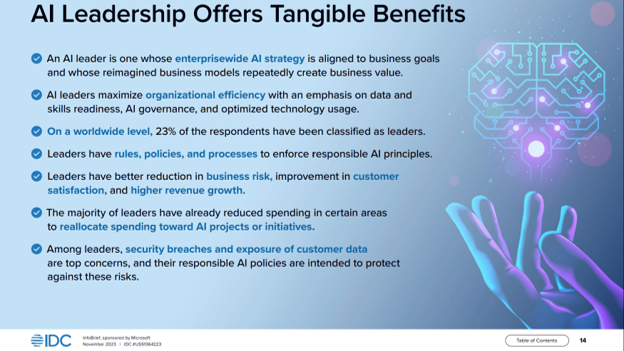
A recent study from IDC shares the attributes of enterprises considered to be leaders in AI; the inference is that taking the lead with AI is as much an art as it is science. The art of successful AI investment comes through executive leadership, a data-driven culture and effective change management. To build successful models, one must be willing to experiment and iterate. One must be willing to fail and learn from failure; this is the cultural attribute that defines companies that lead with AI. The willingness to fail and to learn from failure… and the leadership that enables experimentation and learning from failure. At Microsoft we call this having a growth mindset. And we have built our culture around it.
Change management is the key to enabling the digital culture and will be heavily dependent upon the role of executive leadership, systems thinking and being data driven.
Executive role in culture
The executive role in shaping the culture cannot be overstated and should extend to a clear commitment to culture from the entire leadership. If there is any hesitation or ambivalence, this will permeate the organization and diminish agility. The key attributes of culture of companies that lead with AI are agility, experimentation, focus on learning. The executive community of the organization must be seen to value and exemplify these attributes. The role of the executive community in shaping culture cannot begin and end with a communications plan; it must include explicit display of their own curiosity and willingness to try again and again in order to learn. And the executive community must elevate and applaud those examples of failure that lead to valuable insight.
Systems thinking underpinning culture
As you will see through this document, we strongly encourage defining the business problem to be solved before defining the technical capability. AI investments must take a more wholistic approach to deliver successful results. Systems thinking is an approach to problem solving that considers complex systems as a whole and as such can be an important enabler of AI initiatives. Systems thinking will ask us to understand the interdependencies and relationships between different parts of a system and how changes in one might impact the whole. We consider the business ecosystem (culture, organization, policy, process) and the technical infrastructure of the enterprise to both be parts of the system. Systems thinking helps teams anticipate and mitigate potential risks and unintended consequences of changes in culture, process and technology.
The goal of systems thinking is to enable enterprise teams to establish a systemic approach to improving business capabilities by deploying and operating AI solutions in production and realize value through scale.
Adopting a data-driven culture
Being data-driven is the foundation for leading in the era of AI. Agile experimentation leads to successful outcomes because it uses data to define the hypothesis and data to measure the outcome. The company that is data-driven uses data as the starting point of strategy, operations, and market growth. This puts a great deal of importance on the quality, completeness and fidelity of data. This requires a strong and well-focused data strategy that is perpetual and perennial; it must be considered in every AI initiative and updated with every shift in the system.
Approach to change management
Framework to Industrialize AI
The following diagram illustrates an enterprise framework to industrialize AI and accelerate value. The process involves intake, experimentation, evaluation, and prioritization of the newly raised AI initiative. Once prioritized, the AI platform will require some set up or enhancements before development and deployment of each AI use case. And then the performance of the deployed AI is monitored and outcomes are measured both to provide assurance of intended performance and to provide visibility to future drift. The cycle is closed with feedback loops from the users to developers driving continuous value.
Let’s dig into each area of MAIVA.
MAIVA – AI strategy and platform planning
The AI strategy will be defined by the business strategy and expected outcomes from investment in AI. The AI strategy should be reviewed yearly during annual business planning though the size of investments, often spanning multiple years, would benefit from stability in the AI strategy across planning cycles. It is also a good idea to organize a mid-year, state-of-the-AI strategy review, and surface insights about the positives and challenges faced in that first half of the year.
Part of the AI strategy will include executive sponsorship of the portfolio framework to ensure the appropriate involvement across the enterprise, to ensure that investments are optimal, and to ensure that the expected returns are realized.
Successfully industrializing AI will require an operating model that involves organizational structure, product scope and process structure, as well as an underlayment of security and responsible AI. The goal is to enable AI initiatives through a consistent and controlled cross-functional process, ensuring alignment between business objectives and technical execution while mitigating risk and executing responsibly.
The operating model of industrialized AI is built on common policies for security and responsible AI, data strategy, and data privacy and access policies. Platforming of data and AI will, likewise, serve as a foundational enabler for the operating model; but, platforms will shift and expand as use cases extend into multiple business areas.
The operating model underlying MAIVA will be the blueprint for successful execution and optimized return from AI investments. The key components in that blueprint include the people, process and technologies involved:
-
The people serving on the governing board will come from cross-functional areas of the business and cross-domain technical teams. Participants will include representatives from business teams, finance, marketing, and product teams to articulate the business outcomes from AI. The data, infrastructure and AI technology teams should also be represented. And, security and responsible AI should have seats at the board.
-
The process will involve a singular intake process with common scoping and evaluation criteria, a consistent experimentation process through which the potential viability and success of a proposed initiative might be refined, an agreed upon prioritization approach to identify the sequencing of initiatives, an agile development and deployment process that is grounded in production deployment, and finally an agreed approach to performance measurement and response.
-
The data platforms and AI platforms. These will not be universal. In other words, there will not be one data platform or one AI/ML platform for all initiatives. But they should be more enduring than any single use case or initiative. Scale of AI requires that the components are spread across multiple use cases; otherwise, the cost is prohibitive.
-
Similarly, the data strategy will cover multiple initiatives, but will not be universal. Generally, there will be a family of business processes that will rely upon the same sets of data. These will be enabled by a common data strategy. For example, in the Finance function, there will be procurement processes and payment processes that could all be automated with AI and these will involve the same sets of data and, therefore, they will rely on the same data strategy.
-
The tools that will be required to industrialize AI will drive reporting across the process from intake through to deployment. The process will include measuring performance and use of models as well as the return on investment for the business as measured against original targets. Tools required will also include the specific AI technologies to build and deploy models. And, of course, as mentioned, the data platform and AI/ML platform will be key among the technology required.
There are several policies that should be determined outside of the MAIVA operating model and that are foundational enablers for moving initiatives through the governance process. Security, data privacy and access control, and responsible AI are all policies that should enable key principles for how investments decisions are made.
MAIVA – Innovation, Intake, Experimentation
Experimentation and intake are the start of successful innovation. It is important to start right. The goal is strong alignment between the business strategy and the return expected from qualified and prioritized use cases. Experimentation at the front end will identify expected return, feasibility, and risk mitigation.
This approach requires a series of nested cycles of experimentation: build/deploy - monitor – feedback – use case iteration.
-
As each use case is being considered, there may be additional experimentations required to validate return and basic feasibility. The output of these small cycles of experimentation will be the proposed AI initiatives to consider in the intake process.
-
The intake process will consider newly proposed AI initiatives as well as recommended improvements on existing AI, recommendations coming back from monitoring and feedback.
-
The intake process should deliver a prioritized list of use cases for AI investment - both new use cases and enhancements to already deployed use cases. As the intake process evolves, this prioritized list becomes the managed portfolio of AI initiatives.
-
For prioritized AI investments, each use case will iterate through planning, design and development until the successful use case can be deployed and added to the portfolio of managed AI use cases. This is the AI lifecycle described below.
Lifecycle of an AI Investment
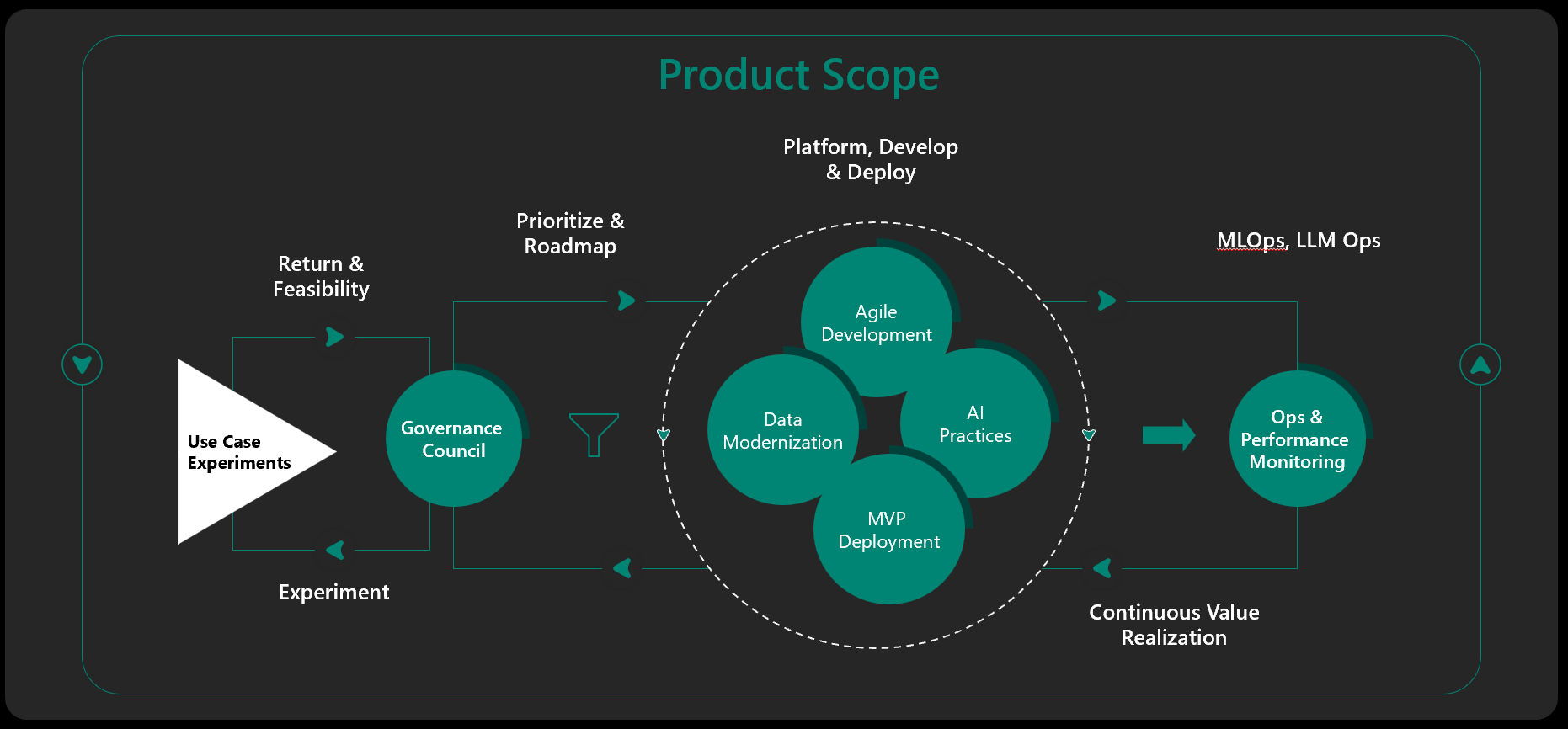
MAIVA – Experimentation
As an AI initiative approaches intake, it may need refinement and some deeper exploration to assess the potential return and feasibility, both of which will impact prioritization.
An experimentation should start with a clear definition of scope and expected outcomes and key results. These quantified results will become the hypotheses of experimentation. Also defined will be the specific user persona and their user stories. As the hypotheses are tested, the experiment should define the expected feasibility, expected return, and viability if developed and deployed to production.
Consider the maturity of data and AI capabilities to address feasibility and viability of the use case. Is the data complete; is the data consistent; is the data accurate… all will be involved in the scope of the use case and iteration through experiments.
As experiments are meant to quickly demonstrate potential value, the AI experiments are often PoCs built with tools that may not be the tool-of choice for an enterprise-scale AI solution. These tools are quicker to build on and more flexible because they do not require the same degree of risk mitigation and security that an enterprise-scaled AI solution would require. This allows for rapid experimentation.
MAIVA – the AI platform, the data platform, and the data (perpetual data strategy)
AI/ML Platform
To industrialize AI at scale requires a common development and deployment approach across a business area whose processes are grounded in common data. The platform should be flexible and extensible enough to allow for scale beyond any given business area. As each use case is taken on, early activity will be to assess the viability of the platform and the data to serve the specific use case. If AI has previously been enabled in the business area, then the platform and data are most likely ready for subsequent use cases. The platform and the data will need to be reviewed and revised for use cases that serve ‘new’ business areas, areas that have not implemented AI. In that case, an additional data strategy should be considered.
A great strategy is to prioritize the business area(s) with the most to gain – greatest efficiencies and cost savings or greatest incremental revenue – from AI. Those areas can anchor in a common platform and common data strategy. As the capability grows, additional lines of business can be taken on, likely with changes to the platform and data.
The AI platform should be enabled with the following:
-
Tooling required for data acquisition and to facilitate experimentation and to train data required in the use case.
-
Configurable deployment and operationalization capabilities that include responsible AI, explainability, transparency and interpretability.
-
Deployment automation code for creating a sandbox environment with standardized libraries, development patterns, unit testing, and smoke testing, and that allows the data science teams to collaborate across operational support teams.
The AI platform may be built around MLOps for Databricks or MLOps for Synapse or yet another MLOps capability. Where generative AI is a technical capability, LLM Ops will be considerably different and the AI platform will need to accommodate this. There is a section later in the playbook that illustrates architectural considerations for MLOps and LLMOps.
Data Platform
Value and outcomes from complex AI solutions are dependent upon a modernized data platform. Typically, the data platform is not a single entity. Indeed, in any given business unit or functional group, there are multiple sources of data and multiple stores of data. And, in most business units, there are multiple enterprise apps, multiple platforms and multiple sources of data, that continue to grow more complex environment. A s organic growth occurs, as acquisitions occur, as re-organizations occur… the breadth of data sources change, leaving the business unit with increasingly complex data space. Now multiply this scenario across every business unit and function in the enterprise. It is this built-in complexity that underpins the need for a robust data strategy.
Industrializing AI will require a governed platform and a strategy to manage complex data. Data modernization within a platform to serve AI is the foundational requirement of MAIVA.
Data Strategy
Data is the currency of business processes. As such, data should be seen as an enabler of business outcomes. An effective data strategy will focus on the line of business and its core processes. Executing the data strategy will free data to harness the power of AI, foster innovation through business use case enablement, and enable core capabilities.
One of the most significant obstacles to enabling AI is legacy data estates. An actionable data strategy will modernize the data estate and support the industrialized value from AI at scale. An effective data strategy starts from the business use case(s), modernizes the data required in the business process and then scales.
To drive scale outcomes, data should be seen as a product. Data should be consistent, secure, meaningful, re-usable, repeatable, versioned and controlled centrally. Business users should be free to understand, access and use data to rapidly create business value with data as a service. To do this a data platform is required at the line of business level.
This is the data strategy implemented in Microsoft’s Finance organization and they’ve called it ‘disciplined at the core, flexible at the edges’: govern and control the data while enabling the business users to use the data to drive innovation and value. This strategy reflects that the driving force of data is giving power to the users and control to the data owners.
Disciplined at the core : Data storage is either centralized or de-centralized with common security, quality and operational and governance rules ensuring data is reliable.
Flexibility at the edge: business users can create their own data products, using configurable and reusable services or simply consume this data to solve business problem and address new opportunities.
MAIVA – Develop, Deploy & Operationalize AI/ML Use Case
Strategic Outcomes Enabled by the Journey of Every Use Case
As stated, the enterprise strategy informs the line of business strategy which in turn informs the portfolio of AI investments. Each AI investment or use case takes a product management approach involving data, agile and iterative development, AI/ML practices, and deployment. Model lifecycle management will establish a standard for model development, training, pipeline management (collect, organize, analyze, and infuse), and deployment.
All use cases are operationalized with feedback loops from users and performance monitoring to track outcomes from the investment in AI. This operationalization is the key to realizing the expected return from AI investment.
Platform, Develop & Deploy: The AI accelerators to get the flywheel started
One consideration for prioritizing AI use cases is optimal return; in other words highest outcome for the least cost. Across AI there are patterns that are commonly repeated in synonymous use cases. For example, revenue forecasting in a finance operations department uses the same time-series classification model as required in retail to predict order volume or demand. Or setting up the environments required to execute similar AI initiatives is another example of commonly repeated patterns. The code that is required in the common patterns is being harvested to create assets that will accelerate the execution of AI initiatives. These accelerators have been curated in the Data Science Toolkit.
The Data Science Toolkit on GitHub, is a growing library of pre-configured and re-usable AI accelerators that help improve the consistency, speed and ability of data science teams to implement common AI-based use cases. API management and configuration guidelines facilitate the publication of models as data products, with consistent, security-enhanced, and compliant endpoints. These accelerators offer an excellent starting point or inaugural use case for the MAIVA framework, simplifying the development and deployment of the use case to broaden the focus to governance and operationalization of AI.
It is important to compartmentalize the core AI technical capabilities required to support the different lines of business. Whilst there are strong, frequent and necessary interactions between the technical and business teams, the core platform capabilities need to be rolled out and implemented in the enterprise with the view of providing consistency across the lines of business at the platform level.
MAIVA – Operationalization
Operationalization is the final stage for every use case. Operationalization is the driver of enduring value from AI governance. It is important to establish best practices and tools to test, deploy, manage, and monitor models in the enterprise production environments. The goal should be to reduce and avoid “technical debt” in AI-based applications.
The picture below shows the iterative cycle that enterprise teams follow to structure their delivery of ML and AI solutions across Process, Platform and People:
The lifecycle for AI resources must be managed consistently with all other on-premises and cloud resources within a CI/CD environment.
Disciplined operationalization will enable rapid, reliable, consistent, secure and safe deployment of AI / ML at scale. There is tremendous value to be gained from a well-defined approach to operationalization; the return on use cases will be higher and the costs to scale will be optimized.
Operationalization within this framework will involve a standardized approach to lifecycle management, a common platform for governance and monitoring of AI, standardardized performance and usage monitoring, as well as any technical engineering standards that underlie enablement of the use case.
The platform will enable integration of the workflow and application, feature stores, model repository and orchestration, and the platform will enable scale through data pipelines and containers common across multiple use cases within the line of business. The platform will also drive reproducible and responsible models that are transparent and explainable.
Similarly, standard performance monitoring will include:
-
Performance of each model, monitoring for accuracy and continued fidelity
-
Performance of each model for outcome and return
-
Portfolio reporting to understand adoption of all models
-
The user experience of each model should include feedback from the user to the development team.
MLOps & LLMOps & GenAIOps
With the rapid evolution of AI solutions and services, operationalization is not a unilateral capability. MLOps will diverge from all generative AI ops; but even among generative AI, operationalization will be different. At the moment, what makes this challenging at the enterprise level is that most enterprise-grade use cases enable complex solutions that involve multiple AI disciplines: machine learning, cognitive services and generative AI. All the more reason to have a disciplined and rigorous approach.
Machine Learning models can be deployed alongside the AI services that wrap them and the applications and consume them as part of a unified release process. Development and Data Science teams need to follow a structured ML Ops process that will enable the following activities in the enterprise:
-
Develop & train model(s) with reusable ML pipelines
-
Package model(s) using containers to capture runtime dependencies for inference
-
Validate model behaviour – functionally, in terms of responsiveness, in terms of regulatory compliance
-
Deploy model(s) - to cloud & edge, for use in real-time / streaming / batch processing
-
Monitor model behaviour & business value, know when to replace / deprecate a stale model
Below is a diagram that illustrates the sequence of these MLOps activities:

The goal is to accelerate the adoption of ML/AI in software solutions and fast delivery of intelligent software.
GenAI and Operationalization
The advent of generative AI is changing operationalization of AI. Indeed, the technology is evolving so quickly that there is not yet a standard for operationalization of all genAI capabilities.
All AI capabilities share a common goal in operationalization to streamline the product lifecycle that consists of design, development, deployment and operations of AI use cases. The commonalities include but are not limited to the need for best practices and iterative approaches to development, evaluation and deployment, scalability, the need for performance monitoring to drive continuous improvement. Additionally, because of genAI, there is growing attention towards ensuring the ethical creation and use of AI-generated content, managing the unpredictability of generative models, balancing creativity with accuracy, among others. Operationalization of genAI extends beyond the traditional scope of MLOps to address the distinct challenges and ethical considerations intrinsic to GenAI.
Currently emerging is an operationalization approach to large language models (LLM) or LLMOps. The diagram below summarizes the shift that is currently happening between MLOps and LLMOps.
Paradigm Shift from MLOps to LLMOps
As generative AI continues to evolve, standards for operationalization of each discipline will also evolve. Meanwhile as these standards emerge, we can illuminate what we know about the lifecycle of generative AI use cases.
GenAI Lifecycle
This diagram presents the lifecycle of GenAI which consists of the following phases:
1. Scope & Foundational GenAI: understand a business use case, collect requirements, and select the appropriate foundational models, such as large language models, small language models or other generative AI models and services. These could include Azure OpenAI APIs, Llama-2, Phi-2, Falcon, DALL-E 2, etc.
2. Data Governance and Management: focus on the data, including data cleaning and enrichment, representation of data as the knowledge (e.g. chunking and vectorization for Retrieval Augmented Generation (RAG) scenario), and ensure adherence to data governance principles.
3. Customize: enrich AI models with domain-specific grounding data and select or optimize various information retrieval approaches, such as text search, vector search, or hybrid search. Include fine-tuning of the GenAI model and/or combining the model with other AI techniques, as well as refining the model based on the overall solution evolution.
4. Prompt Engineering and Refinement: engineer prompts (zero-shot, one-shot, few-shot, chain of thought) and the prompt refinement based on user feedback and solution evolution. It is a critical step for preparing the GenAI model to perform the tasks it will be used for, ensuring that the interactions with the model are as effective and relevant as possible. GenAIOps with Prompt Flow is a template and guidance for building GenAI-infused applications. It offers centralized code hosting, lifecycle management, variant and hyperparameter experimentation, A/B deployment, many-to-many dataset/flow relationships, multiple deployment targets, comprehensive reporting, BYOF (bring-your-own-flows), configuration-based development, local and cloud-based experimentation, prompt evaluation, endpoint testing, and optional Human-in-loop validation. It supports both simple and complex GenAI-infused apps and is highly customizable.
5. Experiment & Evaluate: execute the GenAI flow with additional data or services to evaluate responses from the AI against ground truth or context relevance. Depending on the use case, it may involve benchmarking different models, chunking methods, information retrieval approaches and prompts.
6. Continuous Integration (CI), Continuous Evaluation (CE), and Continuous Deployment (CD): maintain code quality with engineering best practices and manage the promotion of GenAI flows to higher environments. Attention is also given to security measures that include implementing safeguards against the generation of harmful or biased content, securing the prompt data against unauthorized access, and ensuring that the system is secured against potential adversarial attacks.
7. Monitor: monitor performance metrics (quality, ethics, model security) for the GenAI flow, detect the emergence of potential inappropriate outputs, communicate to stakeholders, review and act upon end-user feedback, while ensuring active human oversight.
8. Deployment & Inferencing: package and deploy the GenAI flow as a scalable container for making predictions, secure model access, and enable blue/green deployment with traffic routing control for testing the GenAI flow.
MAIVA Operating model process and roadmap
A governance framework is the foundation of managing a portfolio of AI investments.
The operating model will include the people, the process and the technology involved in governing AI.
A governing body of cross-functional, cross-line-of-business representatives will drive the operating model. The basic function of the governance council will be to intake AI use cases, prioritize those use cases that will be built, and to monitor the performance and return from investments in AI. Governance function will also include alignment to strategy, adherence to responsible AI and security policies of the enterprise, line of business data strategy and platform roadmap, and line of business change management.
The governance board should meet on a regular basis and should include stakeholders from each business unit, functional areas and product unit. Key technology stakeholders will include the owners of the data and platforms serving the business unit and functional areas.
MAIVA intake will evaluate and prioritize both new AI initiatives and those that were deployed and should now be enhanced. New AI initiatives have demonstrated potential outcomes and feasibility through experimentation. As existing AI initiatives mature, they will need to be amended, for example retraining machine learning models to mitigate and avoid drift. New work intake and existing work maintenance both require investment of time and resources; therefore, they should both be prioritized.
Before meeting, the board of stakeholders should review the scope, feasibility, scale and potential return and risk from each initiative proposed. There should be a preliminary decision from each set of stakeholders on each investment decision. If all are aligned, then the investment proposal’s ranking will be defined before the intake meeting. The meeting agenda should be to discuss initiatives for which there is not yet alignment on priority and to set the overall prioritization across new and existing AI initiatives.
The output of the intake process will be a prioritized list of AI investments.
To establish MAIVA’s operating model requires on-going, cross-enterprise commitment and the road map is long-term. The inaugural ‘build’ of the framework will establish the rhythm and the enablers. Organizational enablers, i.e. setting up the intake process and monitoring and establishing key changes such as a common approach to experimentation and product lifecycle will be driven with change management. The goal is to have an established intake rhythm and prioritization process that is driven by the monitoring and feedback from operations.
There will also be technical enablement required to get platforms established, baseline policies gathered, and the data required. Additionally, this will establish the collaboration environment for data scientists to engage with the support engineers monitoring the production environments. The goal is to have the required platform, data and collaboration environment for the initial product build or use case.
With organizational and technical enablers in place, the first use case(s) can be put through the system. Their outcomes and key results quantified and experimentation conducted to drive prioritization through intake will be completed. The design and development will include the appropriate accelerators to enable consistency, and the deployment will demonstrate the expected outcome. Iteration will get through to successful deployment. The target here is to provide demonstration of expected value and the a roadmap to fully deployment.
The inaugural build will also establish the operational enablers, including performance monitoring, reporting and anomaly detection and alerting. The target here is to establish clear lines of feedback to the intake, closing the cycle of the MAIVA system.
Security & Responsible AI considerations in AI governance
As the enterprise looks to drive governance of AI investments, it will be important to establish policies to set common boundaries and mitigate risk. It is well known that AI will not always be accurate or will not always be correct. Thus, the potential for unexpected outcomes means that there should be guardrails defined to protect the company and the public from unintended consequences.
Microsoft has developed a set of human-centered principles to guide the responsible design, development, and deployment of AI technologies and ML as well as the responsible use of AI. These principles are fairness, reliability and safety, privacy and security, inclusiveness, transparency, and accountability. We have established governance of these principles and supporting standards within the Office of Responsible AI and we have expanded awareness and use of these principles in our products, services and commercial lines of business.
The principles and standards of responsible AI use and development should be established by a separate and centralized enterprise organization and its impact should reach all lines-of-business in order to insure that there is a common foundation and like approach across the enterprise. Thus, the responsible AI standards will not be created and managed within the MAIVA governance framework, but the MAIVA governance framework will be dependent upon the responsible AI standard and should align closely.
The Microsoft-RAI-Impact-Assessment-Template.pdf may be helpful in this endeavor. There are links to additional resources in the Resources section of this document.
Security
Security includes the policies, the standards, and the controls that ensure confidentiality, integrity, and accessibility of AI assets and data. Similar to responsible AI principles, security policies and standards should be defined outside of this AI prioritization and governance framework; but the use cases that are prioritized should each be subject to these policies and standards.
Security will focus on data security, platform security, application security, and network security.
-
Data security: This covers the protection of data from unauthorized access, modification, disclosure, or destruction. It includes encryption, masking, anonymization, pseudonymization, and tokenization of the data, as well as access control, authentication, authorization, and auditing of the data.
-
Platform security: This covers the protection of the AI platform and the data platform from unauthorized access, modification, disclosure, or destruction. It includes encryption, hardening, patching, and updating of the platform, as well as access control, authentication, authorization, and auditing of the platform.
-
Application security: This covers the protection of the AI models and applications from unauthorized access, modification, disclosure, or destruction. It includes encryption, signing, testing, and validation of the models and applications, as well as access control, authentication, authorization, and auditing of the models and applications.
-
Network security: This covers the protection of the network and communication channels from unauthorized access, modification, disclosure, or destruction. It includes encryption, firewall, VPN, and SSL/TLS of the network and the communication channels, as well as access control, authentication, authorization, and auditing of the network and the communication channels.
Economics of governance framework (or the opportunity cost)
The economics of AI governance are straightforward: standardize the approach to AI development and manage the portfolio of AI investments for return and feasibility in the context of risk and compliance all to optimize return. Increase return, reduce cost, reduce risk, drive efficiencies – the classic optimization recipe.
The economics of AI are driven by operating costs and capital expense; but with the advent of cloud-based compute and software-as-a-service, operating costs are an increasingly larger part of this economy than capital expense.
-
Operating expenses
-
Licensing
-
Consumption/service fees
-
Maintenance
-
Network cost
-
Platform cost
-
Apps (falls into licensing)
-
Labor
-
-
Capital expense
- Smaller as cloud is primary platform, service and data store
As indicated at the outset, the art behind AI comes from culture, from people and process. AI governance should seek to create a culture of financial responsibility whilst ensuring proper governance in the delivery process and operational activities.
A culture of financial responsibility is one in which each workload team is equipped and motivated to make prudent financial decisions across the product lifecycle. It drives the team to proactively seek out and implement strategies to enhance efficiency and reduce unnecessary expenses.
Some considerations in the context of efficiency and economics of AI governance:
-
Efficiency quotient
-
Standards – both tools and practices – will reduce costs and speed time to launch. Multiple tools may be available, but all options will be standard.
-
Best-in-class tools minimize the need to develop custom solutions for planning, development, testing, collaboration, and continuous integration and continuous delivery (CI/CD).
-
Standard processes & practices in software development and data science drive efficiency
-
Buy vs build – if there is a product on the market that serves the need, reflects future potential and is not relatively prohibitive in licensing fees… it will be more efficient to buy. Build brings cost of ownership (build, maintenance, possibly capex)
-
Standardize app design patterns
-
Standardize testing approach. Shift-left approach to testing by performing unit testing early and often throughout the development process. Frequent testing in each development environment helps developers gain confidence in their applications.
-
follow DevSecOps practices as part of an enterprise standard operating procedures.
-
Standard metrics for software performance and AI performance
-
-
Amplify the value
- Skill non-technical resources with no-code/low-code technologies to empower them to innovate.
-
Manage technical debt –
-
Implement standards and guidelines that help address technical debt.
-
Adopt a mindset that elevates the evaluation of technical debt in the application team’s deliverables.
-
This motivates teams to consider and address technical debt regularly to avoid accumulation.
-
Technical debt should be addressed as a regularly recurring task in the product backlog.
-
Roles Supporting MAIVA
The ongoing framework
Given the process illustrated in the Operating Model section, there will be several roles required as aligned to the primary components of the framework:
Required roles, filled by specific resources
| MAIVA – Governance Role | Perenial Governance Resource | Ad Hoc Resource per use case |
|---|---|---|
| Program management | Line of business executive sponsor | |
| Line of business program management (may be more than one resource) | ||
| Business Analyst(s) | ||
| Technical / Platform management | ||
| Technical/ LOB data management | ||
| Change management architect | ||
| Platform & experimentation | Several architects: security, AI, UX/UI | (Use case specific feature teams) |
| (Use case specific program management teams) | ||
| (use case specific Data scientists, ML engineers, data engineers feature teams) | ||
| Per use case - enablement / deployment | Data scientists, ML engineers, data engineers (feature teams) | |
| App developers(s) (feature teams) | ||
| Product management | ||
| Operationalization | DevOps engineer | |
| Data scientist, data engineers, data analysts | ||
| Advisory | Security | |
| Responsible AI | ||
| Privacy | ||
| Legal | ||
| Finance | ||
| HR | ||
| CX | ||
The inaugural build
The purpose of the inaugural build will be to (1) establish the MAIVA governance operating model and (2) drive the operating model through the first few use cases. The inaugural build will include:
-
Definition and gathering of the governance board
-
Definition of the governance process and frequency
-
Communications strategy
-
Identification of the first use cases to bring through intake
-
The first prioritized roadmap
-
Design, development and deployment of the first one to three use cases
-
Build of the Performance monitoring tools and feedback loops
-
Operationalization of the first use case(s)
-
Roadmap to refine governance
This will require all of the resources identified in the table above. Additionally, this will require a lead business architect, a lead technical architect and a lead change management architect together providing product leadership in the first or inaugural build; consider appointing the change management architect to as lead for the inaugural build. Supporting these three architects may be additional resources within their domains or consultants to support this inaugural build. Supporting the inaugural build, a communications manager to develop a strategy that supports change management and executes communication to employees will be essential. Additionally, project management support will be required to structure the inaugural build project and execution.
Resources
Gratitude for contributors
Many thanks and much appreciation to the following for their contributions and oversight of this effort!
- Willie Ahlers
- Francois Magnin
- Kimberly O’Donoghue
- Ricardo Sousa
- Sofia Noejovich
- Mike Swantek
- Erica Lawrie
- Karsten Strøbæk
- Rick Hines
- Todd Ray
- Philip Carpenter
- Ravi Thoutireddy
- Liana Napalkova
- Michele Usuelli
- Amit Tyagi
- Carlo Binda
